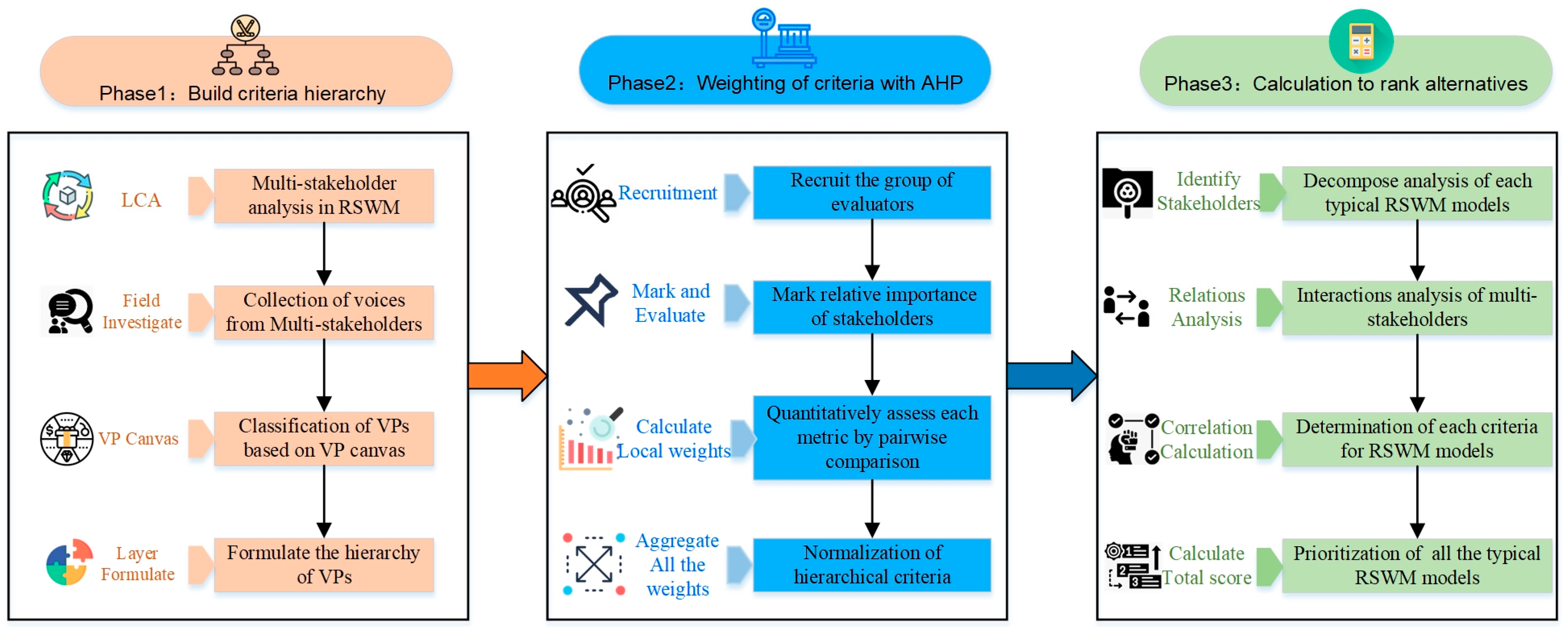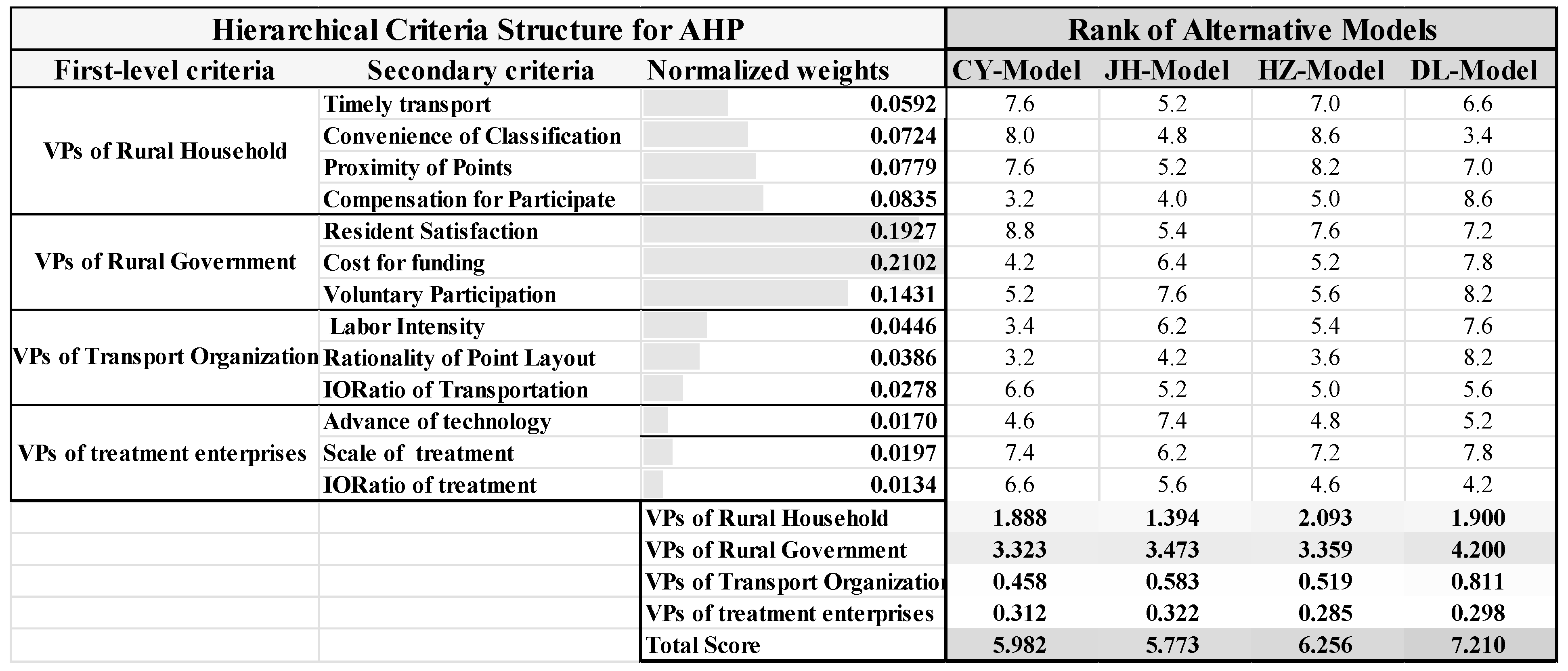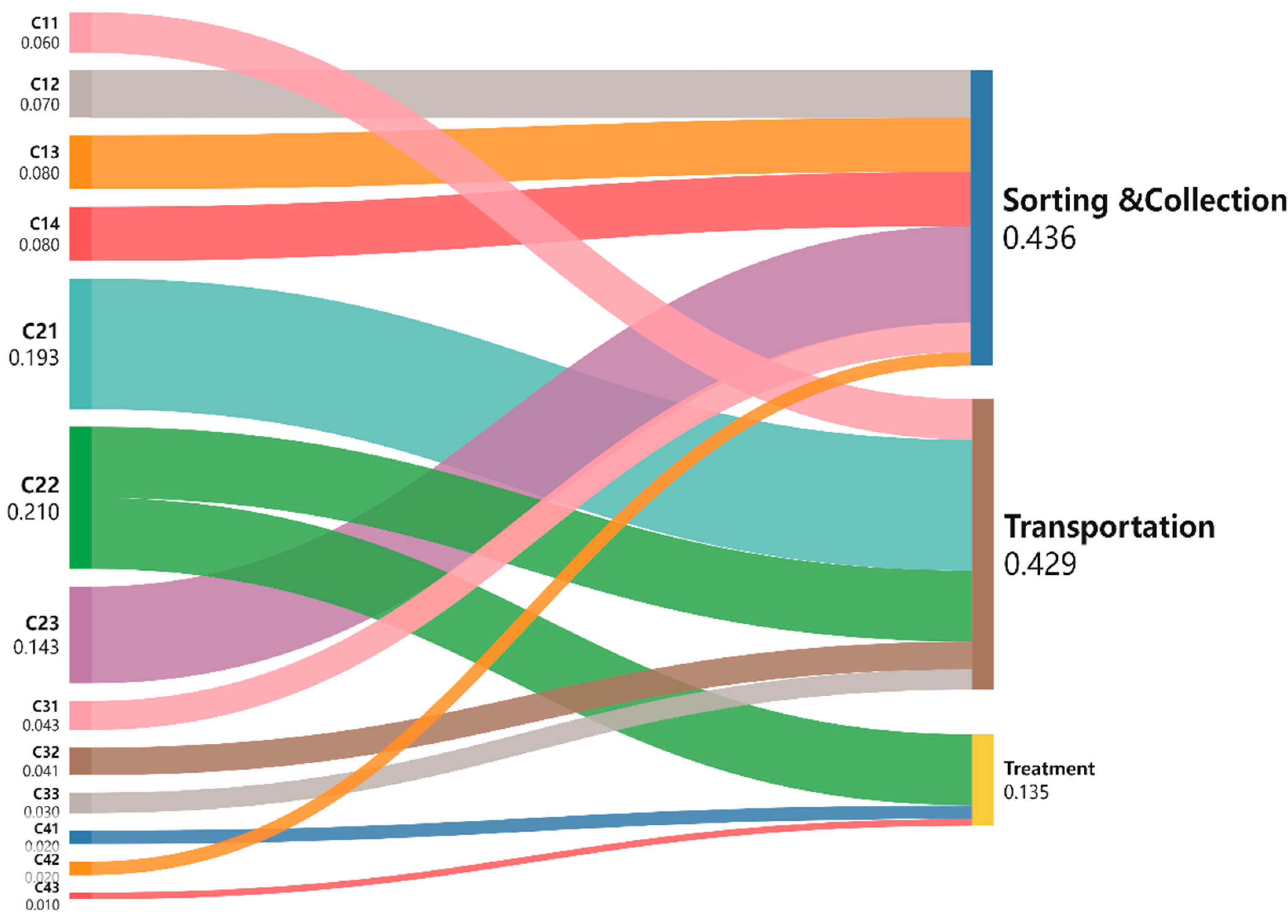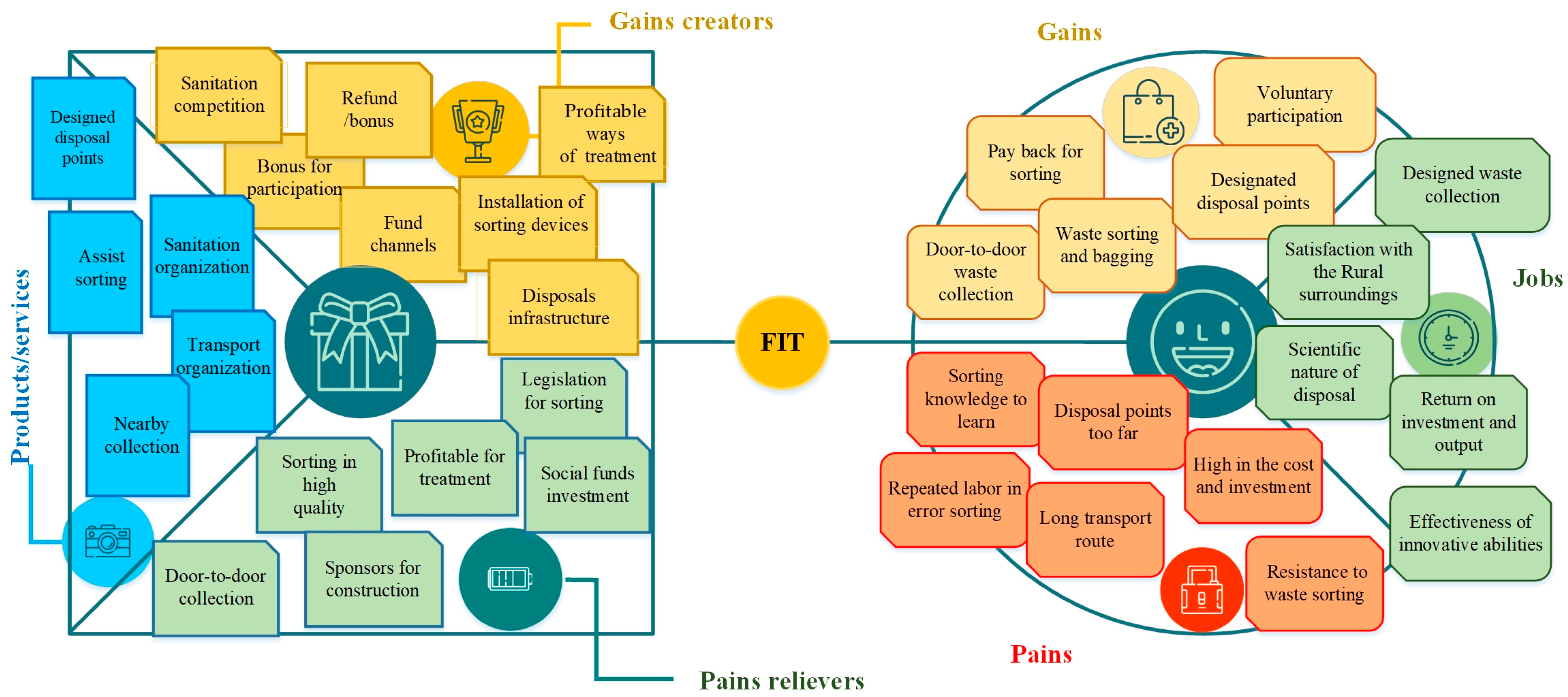An Optimized Method for BMI in Environmental Projects Based on the Value-Oriented AHP
Abstract
1. Introduction
2. Literature Review
2.1. Current Rural Solid Waste Management in China
2.2. Value Proposition-Oriented Methods for Environmental Management
2.3. Assessment Methods for Rural Solid Waste Management Strategy
2.4. Summary of the Literature Review
3. Methodology
3.1. Framework of the Proposed Method
3.2. Building of the Criteria Hierarchy Based on the VPs of Multi-Stakeholders
3.3. Weighting of Criteria with the AHP
3.4. Evaluation of RSWM Models by the Proposed Method
4. Results Analysis and Optimizing the BM of RSWM
4.1. Results of Prioritization with Possible Explanations
4.2. Main Factors and Their Correlations Related to RSWM
4.3. Optimization of the BM of RSWM Based on the Proposed Approach
5. Discussions
5.1. Main Contributions
5.2. Limitations and Opportunities for Future Study
6. Conclusions
Author Contributions
Funding
Data Availability Statement
Acknowledgments
Conflicts of Interest
References
- Han, Z.; Liu, Y.; Zhong, M.; Shi, G.; Li, Q.; Zeng, D.; Zhang, Y.; Fei, Y.; Xie, Y. Influencing factors of domestic waste characteristics in rural areas of developing countries. Waste Manag. 2018, 72, 45–54. [Google Scholar] [CrossRef] [PubMed]
- Wang, F.; Cheng, Z.; Reisner, A.; Liu, Y. Compliance with household solid waste management in rural villages in developing countries. J. Clean. Prod. 2018, 202, 293–298. [Google Scholar] [CrossRef]
- Han, Z.; Zeng, D.; Li, Q.; Cheng, C.; Shi, G.; Mou, Z. Public willingness to pay and participate in domestic waste management in rural areas of China. Resour. Conserv. Recycl. 2019, 140, 166–174. [Google Scholar] [CrossRef]
- Libralato, G.; Ghirardini, A.V.; Avezzù, F. To centralize or to decentralize: An overview of the most recent trends in wastewater treatment management. J. Environ. Manag. 2017, 193, 336–349. [Google Scholar]
- Wu, J.; Xiao, Y.; Wang, R. Village clans and rural households’ willingness to participate in domestic waste governance: Evidence from China. Resour. Conserv. Recycl. 2022, 174, 138951. [Google Scholar]
- Wang, Z.; Zhao, L. Sustainability of Rural Environmental Governance Research on Waste Disposal Issues; Atlantis Press: Amsterdam, The Netherlands, 2019. [Google Scholar]
- Marshall, R.E.; Farahbakhsh, K. Systems approaches to integrated solid waste management in developing countries. Waste Manag. 2013, 33, 988–1003. [Google Scholar] [CrossRef]
- Iwasaki, N. Local Governance and Environmental Sustainability in Minamata City: Beyond Deadlock and Conflict to Multi-Stakeholder Collaboration; IGES: Kanagawa, Japan, 2018. [Google Scholar]
- Geissdoerfer, M.; Savaget, P.; Bocken, N.M.P.; Hultink, E.J. The Circular Economy—A new sustainability paradigm? J. Clean. Prod. 2017, 143, 757–768. [Google Scholar] [CrossRef]
- Hjorth, P.; Bagheri, A. Navigating towards sustainable development: A system dynamics approach. Futures 2006, 38, 74–92. [Google Scholar] [CrossRef]
- Rasche, A.; Gilbert, D.U. Social accountability 8000 and socio-economic development: A critical evaluation. Glob. Soc. Policy 2012, 12, 319–338. [Google Scholar]
- Zeng, C.; Niu, D.; Zhao, Y. A comprehensive overview of rural solid waste management in China. Front. Environ. Sci. Eng. 2015, 9, 949–961. [Google Scholar] [CrossRef]
- Shi, J.G.; Xu, K.; Si, H.; Song, L.; Duan, K. Investigating intention and behaviour towards sorting household waste in Chinese rural and urban–rural integration areas. J. Clean. Prod. 2021, 298, 126827. [Google Scholar] [CrossRef]
- Wang, S.; Liu, J.; Ren, L.; Zhang, K.; Wang, R. The development and practices of strategic environmental assessment in Shandong Province, China. Environ. Impact Assess. Rev. 2009, 29, 408–420. [Google Scholar] [CrossRef]
- Osterwalder, A.; Pigneur, Y. Modeling value propositions in e-Business. In Proceedings of the 5th International Conference on Electronic Commerce, Pittsburgh, PA, USA, 30 September–3 October 2003; pp. 429–436. [Google Scholar]
- Yang, M.; Vladimirova, D.; Evans, S. Value uncaptured perspective for sustainable business model innovation. J. Clean. Prod. 2017, 140, 1794–1804. [Google Scholar] [CrossRef]
- Baldassarre, B.; Calabretta, G.; Bocken, N.M.P.; Jaskiewicz, T. Bridging sustainable business model innovation and user-driven innovation: A process for sustainable value proposition design. J. Clean. Prod. 2017, 147, 175–186. [Google Scholar] [CrossRef]
- Dal Mas, F.; Dicuonzo, G.; Massaro, M.; Dell’Atti, V. Smart contracts to enable sustainable business models. A case study. Manag. Decis. 2020, 58, 1601–1619. [Google Scholar] [CrossRef]
- Smith, S. Business Model Generation: A Handbook for Visionaries Game Changers and Challengers; Wiley: Hoboken, NJ, USA, 2015. [Google Scholar]
- Liao, N.; Lü, F.; Zhang, H.; He, P. Life cycle assessment of waste management in rural areas in the transition period from mixed collection to source-separation. Waste Manag. 2023, 158, 57–65. [Google Scholar] [CrossRef]
- Chen, S.; Huang, J.; Xiao, T.; Gao, J.; Bai, J.; Luo, W.; Dong, B. Carbon emissions under different domestic waste treatment modes induced by garbage classification: Case study in pilot communities in Shanghai China. Sci. Total Environ. 2020, 717, 137193. [Google Scholar] [CrossRef]
- Hoornweg, D.; Bhada-Tata, P.; Kennedy, C. Waste production must peak this century. Nature 2013, 502, 615–617. [Google Scholar] [CrossRef]
- Giusti, L. A review of waste management practices and their impact on human health. Waste Manag. 2009, 29, 2227–2239. [Google Scholar] [CrossRef]
- Liu, J.G.; Diamond, J. China’s environment in a globalizing world. Nature 2005, 435, 1179–1186. [Google Scholar] [CrossRef]
- Wang, A.; Zhang, L.; Shi, Y.; Rozelle, S.; Osborn, A.; Yang, M. Rural solid waste management in China: Status problems and challenges. Sustainability 2017, 9, 506. [Google Scholar] [CrossRef]
- Han, Z.; Liu, D.; Lei, Y.; Wu, J.; Li, S. Characteristics and management of domestic waste in the rural area of Southwest China. Waste Manag. Res. 2015, 33, 39–47. [Google Scholar] [CrossRef]
- Linzner, R.; Salhofer, S. Municipal solid waste recycling and the significance of informal sector in urban China. Waste Manag. Res. 2014, 32, 896–907. [Google Scholar] [CrossRef] [PubMed]
- Thi, A.L.V. Proposal of a combined environmental management solution for municipal solid waste (MSW) separation in a developing country: For pilot realization in Hanoi Vietnam. Int. J. Integr. Eng. 2020, 12, 9–13. [Google Scholar]
- Zhou, C.; Huang, N.; Yang, G.; Ma, S. Assessing the sustainability of municipal solid waste management in China, 1980–2019. Sustain. Horiz. 2022, 2, 100020. [Google Scholar] [CrossRef]
- Bundhoo, Z.M. Solid waste management in least developed countries: Current status and challenges faced. J. Mater. Cycles Waste Manag. 2018, 20, 1867–1878. [Google Scholar] [CrossRef]
- Tan, Z.; Ren, Y.; Han, J.; Chen, S. Evolving pattern and improvement path of China’s solid waste management policies. Chin. J. Popul. Resour. Environ. 2021, 19, 358–368. [Google Scholar] [CrossRef]
- Iyamu, H.O.; Anda, M.; Ho, G. A review of municipal solid waste management in the BRIC and high-income countries: A thematic framework for low-income countries. Habitat Int. 2020, 95, 102097. [Google Scholar] [CrossRef]
- Wang, H.; Jiang, C. Local nuances of authoritarian environmentalism: A legislative study on household solid waste sorting in China. Sustainability 2020, 12, 2522. [Google Scholar] [CrossRef]
- Xiao, S.; Dong, H.; Geng, Y.; Fujii, M.; Pan, H. Greenhouse gas emission mitigation potential from municipal solid waste treatment: A combined SD-LMDI model. Waste Manag. 2021, 120, 725–733. [Google Scholar] [CrossRef]
- Pires, A.; Martinho, G. Waste hierarchy index for circular economy in waste management. Waste Manag. 2019, 95, 298–305. [Google Scholar] [CrossRef] [PubMed]
- Lin, T.; Guo, X.; Zhao, Y.; Pan, L.; Xiao, L. A study of residents’ environmental awareness among communities in a peri-urban area of Xiamen. Int. J. Sustain. Dev. World Ecol. 2010, 17, 285–291. [Google Scholar] [CrossRef]
- Frow, P.; Payne, A. A stakeholder perspective of the value proposition concept. Eur. J. Mark. 2011, 45, 223–240. [Google Scholar] [CrossRef]
- Ulrich, D.; Brockbank, W. The HR Value Proposition; Harvard Business Press: Cambridge, MA, USA, 2005. [Google Scholar]
- Pechancová, V.; Pavelková, D.; Saha, P. Community Renewable Energy in the Czech Republic: Value Proposition Perspective. Front. Energy Res. 2022, 10, 821706. [Google Scholar] [CrossRef]
- Wiśniewska-Paluszak, J.; Paluszak, G.; Fiore, M.; Coticchio, A.; Galati, A.; Lira, J. Urban agriculture business models and value propositions: Mixed methods approach based on evidence from Polish and Italian case studies. Land Use Policy 2023, 127, 106562. [Google Scholar] [CrossRef]
- França, C.L.; Broman, G.; Robert, K.H.; Basile, G.; Trygg, L. An approach to business model innovation and design for strategic sustainable development. J. Clean. Prod. 2017, 140, 155–166. [Google Scholar] [CrossRef]
- Giourka, P.; Sanders, M.W.J.L.; Angelakoglou, K.; Pramangioulis, D.; Nikolopoulos, N.; Rakopoulos, D.; Tryferidis, A.; Tzovaras, D. The smart city business model canvas—A smart city business modeling framework and practical tool. Energies 2019, 12, 4798. [Google Scholar] [CrossRef]
- Carter, M.; Carter, C. The creative business model canvas. Soc. Enterp. J. 2020, 16, 141–158. [Google Scholar] [CrossRef]
- Osterwalder, A.; Euchner, J. Business model innovation: An interview with Alex Osterwalder. Res.-Technol. Manag. 2019, 62, 12–18. [Google Scholar] [CrossRef]
- Pollard, J.; Osmani, M.; Grubnic, S.; Díaz, A.I.; Grobe, K.; Kaba, A.; Panchal, R. Implementing a circular economy business model canvas in the electrical and electronic manufacturing sector: A case study approach. Sustain. Prod. Consum. 2023, 36, 17–31. [Google Scholar] [CrossRef]
- Petrov, I.; Zemtsov, M.; Butyrin, A. Digital transformation method for value mapping in public management. E3S Web Conf. 2019, 110, 02151. [Google Scholar] [CrossRef]
- Marenco-Porto, C.A.; Nieto-Londoño, C.; Lopera, L.; Escudero-Atehortua, A.; Giraldo, M.; Jouhara, H. Evaluation of Organic Rankine Cycle alternatives for the cement industry using Analytic Hierarchy Process (AHP) methodology and energy-economic-environmental (3E) analysis. Energy 2023, 281, 128304. [Google Scholar] [CrossRef]
- Zoma, F.; Sawadogo, M. A multicriteria approach for biomass availability assessment and selection for energy production in Burkina Faso: A hybrid AHP-TOPSIS approach. Heliyon 2023, 9, e20999. [Google Scholar] [CrossRef] [PubMed]
- Bystrzanowska, M.; Tobiszewski, M. How can analysts use multicriteria decision analysis? TrAC Trends Anal. Chem. 2018, 105, 98–105. [Google Scholar] [CrossRef]
- Cobuloglu, H.I.; Büyüktahtakın, İ.E. A mixed-integer optimization model for the economic and environmental analysis of biomass production. Biomass Bioenergy 2014, 67, 8–23. [Google Scholar] [CrossRef]
- Tzeng, L.Y.; Huang, R.J.; Shih, P.T. Revisiting almost second-degree stochastic dominance. Manag. Sci. 2013, 59, 1250–1254. [Google Scholar] [CrossRef]
- Castañeda, M.; Arlandi, M.; Ordás, F. AHP algorithm used to select suitable abandoned underground mines for energy storage infrastructure–iCAES technology. A specific case study for León (Spain). Heliyon 2023, 9, e20045. [Google Scholar]
- Ooi, J.; Promentilla, M.A.B.; Tan, R.R.; Ng, D.K.; Chemmangattuvalappil, N.G. A systematic methodology for multi-objective molecular design via analytic hierarchy process. Process Saf. Environ. Prot. 2017, 111, 663–677. [Google Scholar] [CrossRef]
- Soltani, A.; Hewage, K.; Reza, B.; Sadiq, R. Multiple stakeholders in multi-criteria decision-making in the context of municipal solid waste management: A review. Waste Manag. 2015, 35, 318–328. [Google Scholar] [CrossRef]
- Cheng, B.; Chang, R.; Yin, Q.; Li, J.; Huang, J.; Chen, H. A PSR-AHP-GE model for evaluating environmental impacts of spoil disposal areas in high-speed railway engineering. J. Clean. Prod. 2023, 388, 135970. [Google Scholar] [CrossRef]
- Santoyo-Castelazo, E.; Azapagic, A. Sustainability assessment of energy systems: Integrating environmental economic and social aspects. J. Clean. Prod. 2014, 80, 119–138. [Google Scholar] [CrossRef]
- Ripa, M.; Fiorentino, G.; Vacca, V.; Ulgiati, S. The relevance of site-specific data in Life Cycle Assessment (LCA). The case of the municipal solid waste management in the metropolitan city of Naples (Italy). J. Clean. Prod. 2017, 142, 445–460. [Google Scholar] [CrossRef]
- Yay, A.S.E. Application of life cycle assessment (LCA) for municipal solid waste management: A case study of Sakarya. J. Clean. Prod. 2015, 94, 284–293. [Google Scholar]
- Zhai, K.; Lu, S. Discussion on key influencing factors of construction and demolition waste recovery and recycling management in China. IOP Conf. Ser. Earth Environ. Sci. 2021, 719, 042019. [Google Scholar] [CrossRef]
- Saaty, T.L. A scaling method for priorities in hierarchical structures. J. Math. Psychol. 1977, 15, 234–281. [Google Scholar] [CrossRef]
- Zhao, A.; Zhang, L.; Ma, X.; Gao, F.; Zhu, H. Effectiveness of Extrinsic Incentives for Promoting Rural Waste Sorting in Developing Countries: Evidence from China. Dev. Econ. 2022, 60, 123–154. [Google Scholar] [CrossRef]
- He, P.J. Municipal solid waste in rural areas of developing country: Do we need special treatment mode? Waste Manag. 2012, 32, 1289–1290. [Google Scholar] [CrossRef]








| Stakeholder | Job Performance | Pain Points | Expectations |
|---|---|---|---|
| Rural Households | Clean surrounding environment, timely waste transfer, neat village appearance | Recycling point too far, difficult waste sorting methods, lack of reward for extra sorting labor | Door-to-door collection, payment for waste collection, psychological rewards like honorary titles |
| Rural Government | Village appearance, resident satisfaction, effectiveness of waste classification promotion | High financial input, resident complaints, repetitive labor, investment | Households’ autonomous classification, low-cost transfer, policy subsidies, fund recovery, legal regulations |
| Transfer Enterprises (Individuals) | Labor intensity during collection, transfer timeliness and efficiency, service profit growth | Poor initial classification, manual sorting, unscientific collection points distribution, health and hygiene risks | Higher recycling value and profit, automated and unmanned sorting, increased bargaining power |
| Resource Recovery Enterprises | Waste processing capacity, processing efficiency, waste processing cost | Production interruptions due to discontinuous recycled materials, high costs leading to losses | Higher government subsidies, advanced harmless processing technology, cost savings through automation |
| Based on Means | C1 | C2 | C3 | C4 |
|---|---|---|---|---|
| C1 | 1 | 5/11 | 17/5 | 29/5 |
| C2 | 11/5 | 1 | 31/5 | 37/5 |
| C3 | 5/17 | 5/31 | 1 | 17/5 |
| C4 | 5/29 | 5/37 | 5/17 | 1 |
| Indicators’ correlations | C1 | C2 | C3 | C4 | |
| C1 | Pearson coefficient | 1 | 0.058 | 0.026 | −0.316 |
| C2 | Pearson coefficient | - | 1 | 0.776 ** | 0.198 |
| C3 | Pearson coefficient | - | - | 1 | 0.096 |
| C4 | Pearson coefficient | - | - | - | 1 |
| Correlation | C11 | C12 | C13 | C14 | C21 | C22 | C23 | C31 | C32 | C33 | C41 | C42 | C43 |
| C11 | 1 | 0.500 | 0.695 | 0.041 | 0.667 | −0.287 | −0.498 | −0.295 | −0.042 | 0.427 | −0.609 | 0.661 | 0.218 |
| C12 | - | 1 | 0.532 | −0.622 | 0.554 | −0.810 | −0.867 | −0.702 | −0.766 | 0.215 | −0.475 | 0.031 | 0.286 |
| C13 | - | - | 1 | 0.018 | 0.680 | −0.313 | −0.569 | −0.235 | −0.076 | 0.193 | −0.657 | 0.544 | 0.067 |
| C14 | - | - | - | 1 | −0.104 | 0.726 | 0.591 | 0.667 | 0.874 | −0.118 | −0.140 | 0.298 | −0.629 |
| C21 | - | - | - | - | 1 | −0.432 | −0.519 | −0.517 | −0.161 | 0.411 | −0.693 | 0.558 | 0.278 |
| C22 | - | - | - | - | - | 1 | 0.864 | 0.870 | 0.785 | −0.190 | 0.350 | 0.243 | −0.323 |
| C23 | - | - | - | - | - | - | 1 | 0.761 | 0.700 | −0.181 | 0.476 | −0.025 | −0.344 |
| C31 | - | - | - | - | - | - | - | 1 | 0.806 | −0.179 | 0.348 | 0.150 | −0.461 |
| C32 | - | - | - | - | - | - | - | - | 1 | 0.005 | 0.072 | 0.352 | −0.407 |
| C33 | - | - | - | - | - | - | - | - | - | 1 | −0.425 | 0.437 | 0.384 |
| C41 | - | - | - | - | - | - | - | - | - | - | 1 | −0.347 | 0.176 |
| C42 | - | - | - | - | - | - | - | - | - | - | - | 1 | 0.195 |
| C43 | - | - | - | - | - | - | - | - | - | - | - | - | 1 |

Disclaimer/Publisher’s Note: The statements, opinions and data contained in all publications are solely those of the individual author(s) and contributor(s) and not of MDPI and/or the editor(s). MDPI and/or the editor(s) disclaim responsibility for any injury to people or property resulting from any ideas, methods, instructions or products referred to in the content. |
© 2024 by the authors. Licensee MDPI, Basel, Switzerland. This article is an open access article distributed under the terms and conditions of the Creative Commons Attribution (CC BY) license (https://creativecommons.org/licenses/by/4.0/).
Share and Cite
Liu, Y.; Liu, W. An Optimized Method for BMI in Environmental Projects Based on the Value-Oriented AHP. Systems 2024, 12, 519. https://doi.org/10.3390/systems12120519
Liu Y, Liu W. An Optimized Method for BMI in Environmental Projects Based on the Value-Oriented AHP. Systems. 2024; 12(12):519. https://doi.org/10.3390/systems12120519
Chicago/Turabian StyleLiu, Yuanyuan, and Wei Liu. 2024. "An Optimized Method for BMI in Environmental Projects Based on the Value-Oriented AHP" Systems 12, no. 12: 519. https://doi.org/10.3390/systems12120519
APA StyleLiu, Y., & Liu, W. (2024). An Optimized Method for BMI in Environmental Projects Based on the Value-Oriented AHP. Systems, 12(12), 519. https://doi.org/10.3390/systems12120519






